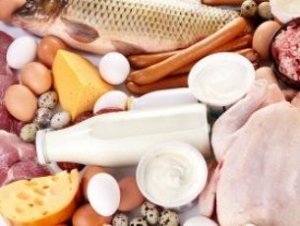Dairy farming

McDonald’s also announced recently they would begin using real butter. With all this attention on dairy, I began wondering about consumer trends, writes David Widmar, agricultural economist and editor of Agricultural Economics Insights.
Trending Higher
The dairy trend I’ve seen referenced most frequently in the media has been increased butter consumption (Figure 1).
In the early 1980s annual butter consumption reached nearly 5 pounds per person. Never quite breaking above 5 pounds/person/year, consumption drifted lower through the 1990s.
By 2008 per capita butter consumption was again on the rise and exceeded 5 pounds. Most recently (2014), butter consumption reached a 39 year high of 5.5 pounds per person.
 Figure 1. US Consumption of Butter, Per Capita. Pounds per Person. 1975-2014. Data Source: USDA ERS.
Figure 1. US Consumption of Butter, Per Capita. Pounds per Person. 1975-2014. Data Source: USDA ERS.
Even more dramatic than the increases in butter consumption is what has occurred with yoghurt (Figure 2). Yoghurt consumption skyrocketed from 2 pounds per person (annually) in 1975 to nearly 15 pounds in 2014.
A linear trend line from 1990 to 2014 (not shown) indicates yoghurt consumption increased at an annual rate of 0.49 pounds per person per year. At nearly half a pound per person, that is an incredible rate of increase sustained over 24 years.
 Figure 2. US Consumption of Yoghurt, Per Capita. Pounds per Person. 1975-2014. Data Source: USDA ERS.
Figure 2. US Consumption of Yoghurt, Per Capita. Pounds per Person. 1975-2014. Data Source: USDA ERS.
Yet another increase in dairy consumption has occurred with cheese (figure 3). While consumption of American cheeses1 (in blue) has been flat since the 1980s and Cottage cheese (in green) has trended lower, consumption of Other Cheeses2 (in red) has trended higher.
Consumption of Other Cheeses increased from 6 pounds per capita in 1975 to more than 20 pounds in 2014. The increases in Other Cheeses is equal to a trend line increase of 0.39 pounds per person per year.
It’s interesting to note that consumption of Other Cheeses dipped in 2008 and 2009, corresponding with the Great Recession. Maybe cheese consumption holds some insight on the health of the broader economy.
 Figure 3. US Consumption of Cheese – American, Other, and Cottage, Per Capita. Pounds per Person. 1975-2014. Data Source: USDA ERS.
Figure 3. US Consumption of Cheese – American, Other, and Cottage, Per Capita. Pounds per Person. 1975-2014. Data Source: USDA ERS.
Not all Dairy Products are Trending Higher
While consumption of butter, yoghurt, and certain cheeses has trended higher, the trend towards increased consumption has not held across all dairy products.
Consumption of fluid milk has contracted sharply since 1975 (Figure 4). In 1975 per capita consumption was 247 pounds; it had declined to 159 pounds by 2014.
A trend line of these data (not shown) report a contraction in milk consumption at a rate of 2.0 pounds per person per year. Certainly a rate of decline that becomes significant over several years and cannot be ignored.
 Figure 4. US Consumption of Fluid Milk, Per Capita. Pounds per Person. 1975-2014. Data Source: USDA ERS.
Figure 4. US Consumption of Fluid Milk, Per Capita. Pounds per Person. 1975-2014. Data Source: USDA ERS.
Ice cream is another dairy product Americans have cut back on (Figure 5). This reduction is most obvious with regular fat ice cream products (in blue, decreasing from 18 pounds in 1975 to less than 13 in 2014) but reduced fat ice cream consumption wasn’t immune (in red, decreasing from 7.7 pounds in 1975 to 6.3 pounds in 2014).
 Figure 5. US Consumption of Ice Cream, Regular and Reduced Fat, Per Capita. Pounds per Person. 1975-2014. Data Source: USDA ERS.
Figure 5. US Consumption of Ice Cream, Regular and Reduced Fat, Per Capita. Pounds per Person. 1975-2014. Data Source: USDA ERS.
The Big Picture
While consumption trends of specific dairy products has varied, it’s important to consider the net impact on total dairy consumption.
In figure 6, the total dairy consumption, on a milk-fat milk-equivalent basis, is shown. These data are based on the milk fat content of specific dairy products and provides a measure of how many pounds of milk (based on milk-fat) are needed.
Total dairy consumption can change quite a bit from year to year, but since the mid-1990s the trend has been for higher total dairy consumption in the US. The most recent data (2014) report the highest consumption since 1975.
 Figure 6. US Consumption of All Dairy Products, Milk-Fat Milk-Equivalent Basis, Per Capita. Pounds per Person. 1975-2014. Data Source: USDA ERS.
Figure 6. US Consumption of All Dairy Products, Milk-Fat Milk-Equivalent Basis, Per Capita. Pounds per Person. 1975-2014. Data Source: USDA ERS.
Wrapping It Up
Trends are tricky as they can be slow to develop and track. In some cases, trends may be underway but overlooked as they are slow changes playing out over several years or decades.
Yoghurt is great example of a trend that spent years sneaking up on us. While Greek yoghurt has been a popular new trend in the yoghurt section, the overall trend of higher yoghurt consumption has been under way for decades.
In short, the dairy sector is one of significant but slow changes. Over nearly four decades, per capita consumption has trended higher for butter, yoghurt, and some cheeses. At the same time, consumption of fluid milk and ice cream has trended lower.
As consumer trends continue to unfold, expect even more changes in the grocery store displays, in supply chain investments, and, eventually, at the farm-level.
This article first appeared on Agricultural Economic Insights’ Blog.
David Widmar is an agricultural economist specialising in agricultural trends and producer decision-making. Through his research, he supports agribusinesses and farmers in their strategic and planning efforts. David can be reached by email. Follow David on twitter @davidwidmar.
1American cheeses are Cheddar, Colby, Monterey, and Jack (http://www.ers.usda.gov/media/146945/ldpm19301_1_.pdf).
2Other Cheeses include Mozzarella, Parmesan, Provolone, Ricotta, Swiss, Hispanic varieties, and others. (http://www.ers.usda.gov/media/146945/ldpm19301_1_.pdf).
TheCattleSite News Desk






















